Get into the greasy science of diacetyl production by brewer’s yeast and discuss how to keep the butter at bay in your homebrew. We’ll explore how yeast creates and clears away the Vicinal Diketones (VDKs) that make beer smell like a movie theater, identify which parts of the brewing process can be control points, and give you the tools to troubleshoot a butterbomb. Finally, we’ll outline practical methods for testing for VDKs so you can reliably identify when a beer is good to go and when it might need a few more days.
Learning Objectives
- Learn how strain selection and yeast health can affect diacetyl formation and uptake
- Understand what aspects of the brewing process can contribute to excessive diacetyl in a finished beer, including the role that bottle-carbonation can play
- Come away from this presentation with an understanding of how diacetyl and 2,3-Pentanedione are formed and reduced in the course of normal yeast metabolism
- Examine practical methods for testing for VDKs in beer, including how to set up your own sensory panel and assess individual thresholds
About the Speaker
Alex Gruber is a Technical Service Specialist at Imperial Yeast in Portland, Oregon. Alex holds a degree in Food Science & Technology with a focus in Fermentation from Oregon State University. Prior to choosing a career that satisfied his endless fascination with the microscopic side of fermented products, Alex brewed in the U.S. and in Europe, moved a lot of beer in and out of barrels, and cooked professionally for several years. He currently teaches cell counting classes for brewers at Imperial Yeast and does his best to translate academic research into practical information to help brewers make their best beer.
Access premium member content for $4.99/month. Join Now
Access premium member content for $4.99/month
Join for $4.99Already a member? Login here
